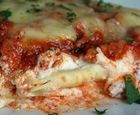|
Italian Entree
Lasagna
(Serves 6-8)
Almost everyone has a favorite recipe for lasagna. But in case you don't, here's a tasty one.
Meat sauce *
1/2 lb. sweet or spicey Italian sausage (your preference)
1 1/4 lb. ground beef (or ground turkey or a combo)
1 C onion (diced)
2-3 cloves garlic (minced or crushed)
1 28 oz. can crushed tomatoes
2 6 oz. cans tomato paste
1 6.5 oz. cans canned tomato sauce
1/2 C red wine (or water)
1/2 C beef broth
2 T brown sugar
1 1/2 tsp. dried basil
1/2 tsp. fennel seeds
1 tsp. Italian seasoning (see sidebar)
1 T salt
1/4 tsp. ground black pepper
4 T fresh parsley (chopped)
_____________
Cheese filling
16 oz. ricotta cheese**
2 eggs (beaten)
1/2 tsp. salt
1 C grated Parmesan (divided into thirds)
_____________
12 lasagna noodles (about 1 box)
3/4 lb. mozzarella cheese (shredded)
Sauce:
• Chop sausage into small bits.
• In a deep, heavy skillet over medium heat cook meat and onions till meat is browned and onion translucent—about 10 minutes. Add garlic toward end, and cook 3 more minutes.
• Pour off most of the fat, leaving a little for flavor.
• Stir in crushed tomatoes, tomato paste, tomato sauce, wine and broth.
• Add the remaining sauce ingredients (seasonings).
• Cover, turn down heat to low, and cook, for about 1 1/2 hours. Be sure to stir occasionally to keep the sauce from burning at the bottom.
Noodles: in a large pot of boiling water, cook the lasgna noodles according to package directions. Drain and rinse with cold water. Set aside.
Filling: in a mixing bowl, combine ricotta with beaten eggs, 1/2 tsp. salt and 1/3 C Parmesan.
Preheat oven to 375 degrees.
Assembly:
• Spread 1 1/2 C of meat sauce in the bottom of a 9x13 baking dish.
• Arrange 6 noodles lengthwise over meat sauce.
• Spread with 1/2 of the ricotta cheese mixture. Sprinkle with 1/2 C of mozzarella and 1/3 C of the Parmesan.
• Spoon another 1 1/2 C of meat sauce over mozzarella and Parmesan
• Add another layer of 6 noodles, ricotta, mozzarella and Parmesan.
• Cover with foil, trying to make sure the foil doesn't touch the cheese.
Bake covered for 25 minutes. Remove foil, and bake an additional 25 minutes. Cool for 15 minutes before serving.
* This makes more sauce than you'll need...so freeze what's left over for another use...spaghetti?
** Some cooks substitue cottage cheese for ricotta. It's delicious!
| See more Italian recipes |
|
|
Tips & Glossary
Arborio Rice: a medium-grained rice. Its high starch content yields a creamy texture and is the basis for risotto.
Balsamic Vinegar: dark, thick vinegar with a sweet pungent flavor. Fermented, concentrated, and aged in wooden casks, sometimes up to 12 years. Can be pricey.
Caper: salty, pickled bud of spiny shrub native to the Mediterranean region. Most prized is the non-pareil, the smallest (approx. 1/8”), though other sizes are tasty and less expensive.
Formaggio: Cheese! Like France, Italy is a land of sublime cheeses, some 400 varieties. Here are some of the most widely sold in the U.S.
• Asiago (Alpine region; smooth or crumbly, great for grating.)
• Fontina (Alpine region; a Gruyere- or Swiss-type cheese with nutty flavor.)
• Mascarpone (southwest of
Milan; triple-cream, smooth and easily spread; used in Tiramisu.)
• Mozzarella (generic term for semi-soft cheese; “fresh” is eaten the day it is made; “buffalo” is from water buffalo. Used in lasagna and pizza when dried slightly.)
• Parmigiano Reggiano (Parma area; the true Parmesan, whose designation is strictly controlled in Italy.)
• Pecorino Romano (made of sheep’s milk; mostly from Sardinia. A hard, salty cheese used for grating.)
• Provolone (mostly from northern Italy; semi-hard, varying from mild to sharp flavor.)
• Ricotta (made of whey, a by-product of making other cheese; soft and creamy like cottage cheese. Used in lasagna.)
• Romano (an American term for Pecorino Romano and other cheeses.)
Italian Seasoning: blend of dried herbs used in Italian cooking—marjoram, thyme, rosemary, savory, sage, oregano, and basil. Packaged commercially and found in most food stores. You can also make your own.
Olive Oil: There's much more to know than is room for here. To learn all you need to know about the different grades of oil, and much, much more, head to Tanbourit.
Pine Nuts: pinoli or pignoli; edible seeds of pine trees used in pesto sauce. Before cooking, release flavor by lightly browning in a heated skillet.
Plum Tomatoes: aka Italian tomatoes; oval-shaped. Used in sauces because they are meatier with fewer seeds than standard tomatoes.
Roasted peppers: buy or make your own: place under a broiler, or hold over a gas flame, till skin chars and blisters. Place in a closed paper bag for 15-20 minutes (to steam them). When cool, the skins slip off under water.
Prosciutto: especially Prosciutto di Parma, dry-cured ham from Parma. The real deal! Cured up to 2 years, is almost sweet and very expensive. You can substitute with capicola, a delicious, light peppery ham.
|
![]()

